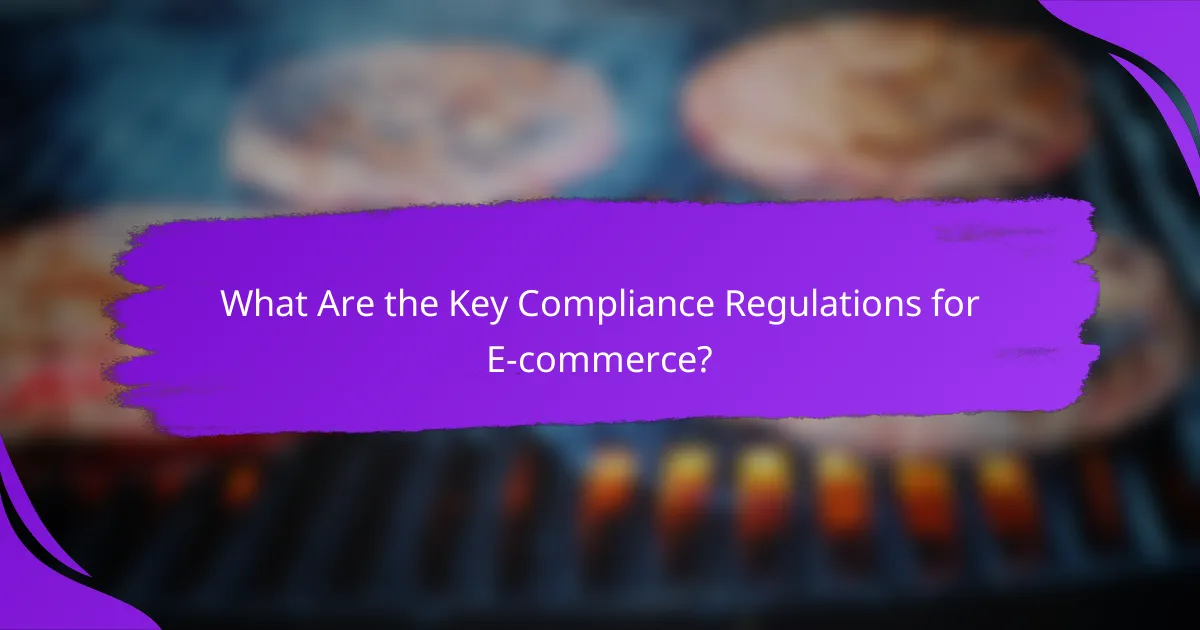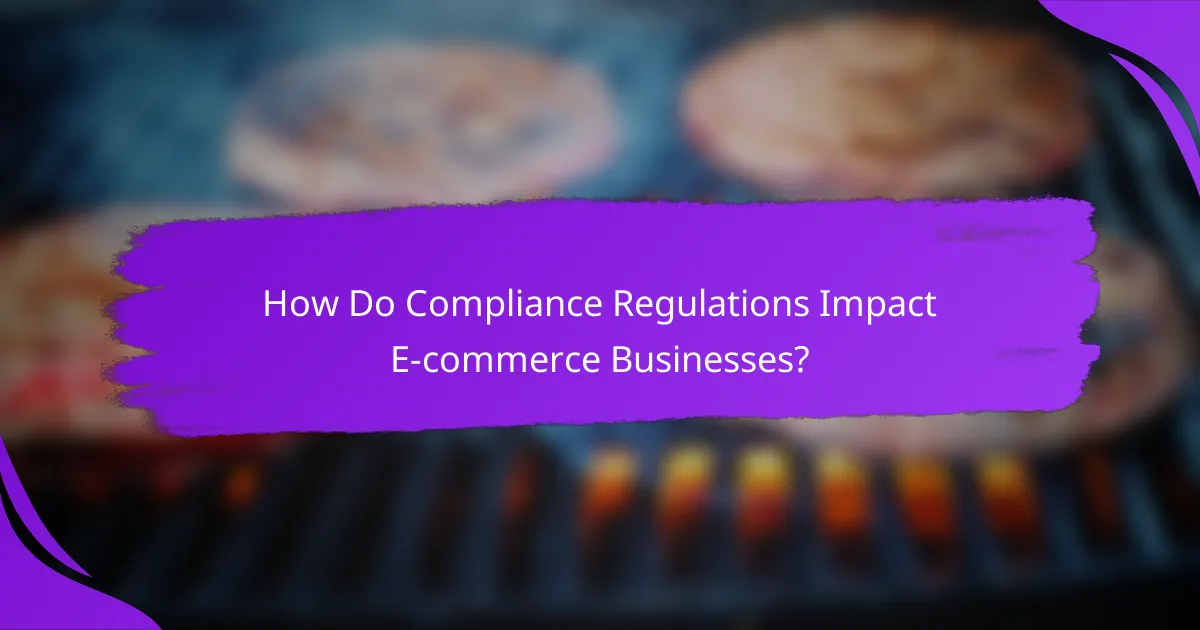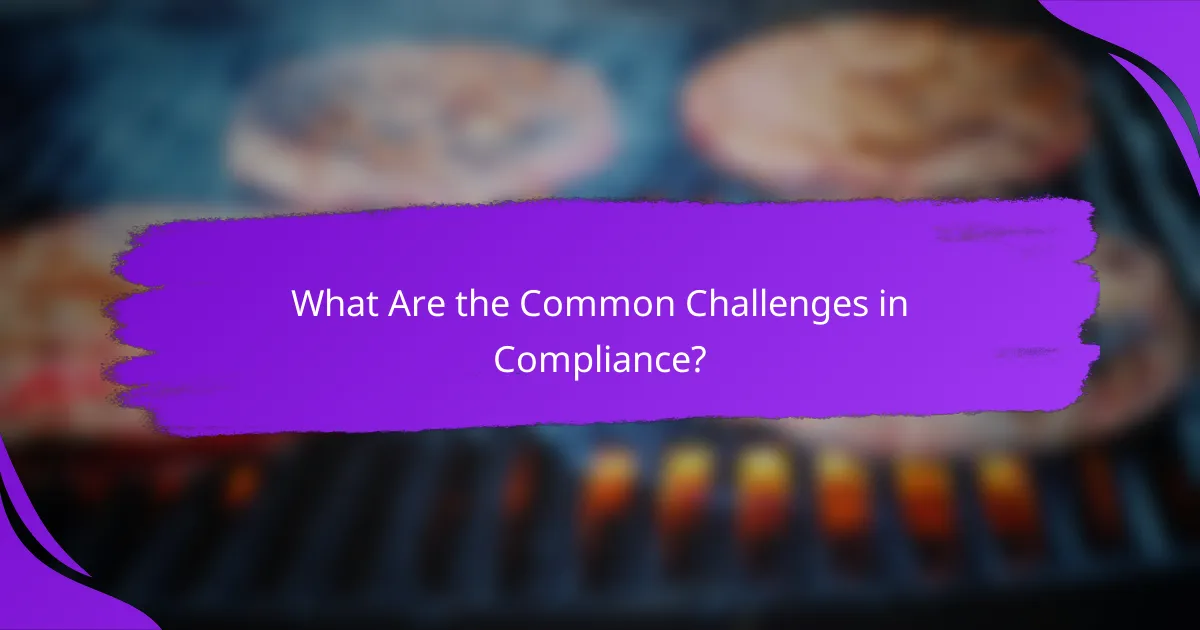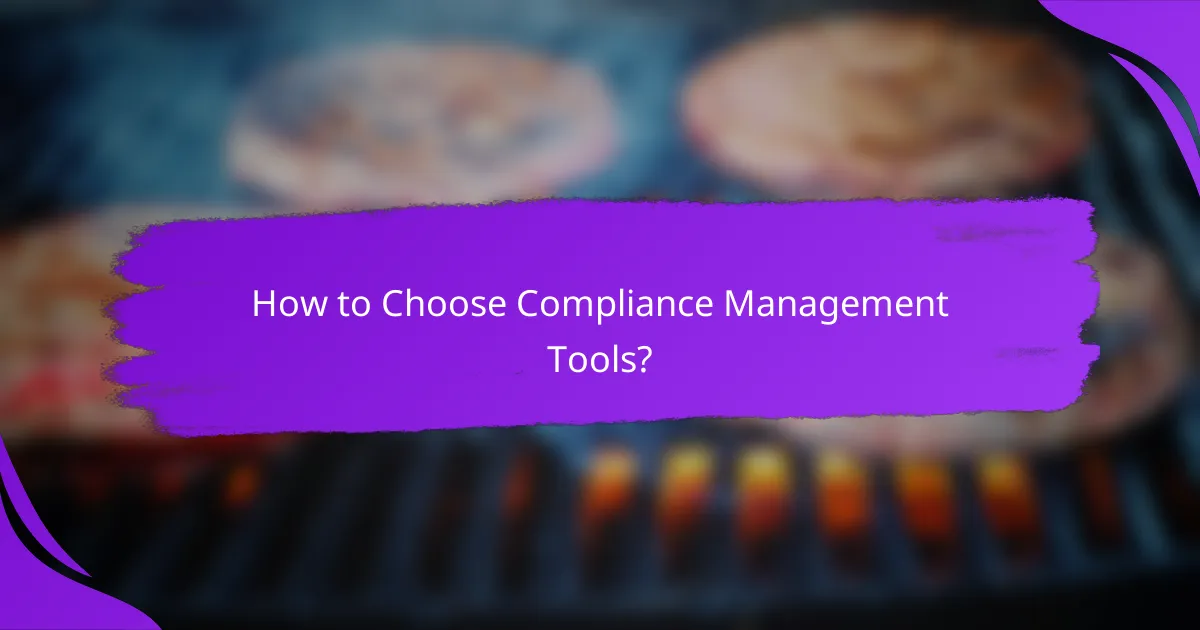Compliance regulations play a crucial role in shaping the e-commerce landscape, dictating how businesses manage data protection, consumer privacy, and payment security. While adherence to these regulations can foster consumer trust and operational integrity, it also presents challenges such as resource allocation and the need for ongoing adaptation to evolving legal standards.

What Are the Key Compliance Regulations for E-commerce?
Key compliance regulations for e-commerce include laws and standards that govern data protection, consumer privacy, payment security, and product safety. Understanding these regulations is essential for businesses to avoid legal penalties and build consumer trust.
GDPR Overview
The General Data Protection Regulation (GDPR) is a comprehensive data protection law in the European Union that affects any business handling personal data of EU citizens. It mandates strict consent requirements, data breach notifications, and the right for individuals to access and delete their data.
Businesses must implement measures to ensure data protection by design and by default. Non-compliance can result in hefty fines, often reaching up to 4% of annual global turnover or €20 million, whichever is higher.
CCPA Overview
The California Consumer Privacy Act (CCPA) grants California residents rights regarding their personal information held by businesses. It requires transparency about data collection practices and provides consumers with the right to opt-out of the sale of their data.
Companies must disclose the categories of personal information collected and the purposes for which it is used. Violations can lead to fines of up to $7,500 per intentional violation, emphasizing the importance of compliance for e-commerce businesses operating in California.
PCI DSS Requirements
The Payment Card Industry Data Security Standard (PCI DSS) outlines security measures for organizations that handle credit card information. Compliance involves maintaining a secure network, implementing strong access control measures, and regularly monitoring and testing networks.
Merchants must ensure that sensitive cardholder data is encrypted and stored securely. Failure to comply can result in fines and increased transaction fees, making adherence crucial for e-commerce operations.
FDA Regulations for E-commerce
The Food and Drug Administration (FDA) regulates the sale of food, drugs, and medical devices online. E-commerce businesses must comply with labeling requirements, safety standards, and advertising regulations to ensure consumer safety and product efficacy.
For instance, dietary supplements sold online must meet specific labeling guidelines and cannot make unverified health claims. Non-compliance can lead to product recalls and legal action, impacting business reputation and sales.
FTC Guidelines
The Federal Trade Commission (FTC) provides guidelines to protect consumers from deceptive advertising and unfair business practices in e-commerce. Businesses must ensure that marketing claims are truthful and not misleading.
Additionally, the FTC requires clear disclosures for endorsements and testimonials. Companies should regularly review their advertising practices to avoid penalties, which can include fines and mandated corrective actions.

How Do Compliance Regulations Impact E-commerce Businesses?
Compliance regulations significantly affect e-commerce businesses by imposing legal requirements that govern operations, data handling, and customer interactions. Adhering to these regulations can enhance operational integrity but may also introduce challenges and costs that businesses must navigate effectively.
Operational Changes
Compliance regulations often necessitate substantial operational changes within e-commerce businesses. Companies may need to implement new processes for data protection, customer verification, and transaction monitoring to meet legal standards. For example, adhering to the General Data Protection Regulation (GDPR) in Europe requires businesses to enhance their data handling practices, which can lead to the adoption of new technologies and training programs.
Additionally, businesses may need to revise their supply chain management to ensure that all partners comply with relevant regulations. This can involve conducting regular audits and assessments to maintain compliance across the board.
Cost Implications
The financial impact of compliance regulations on e-commerce businesses can be significant. Costs may arise from implementing new systems, hiring compliance officers, and conducting employee training sessions. These expenses can vary widely, but businesses should expect to allocate a portion of their budget—often in the low tens of percent of overall operational costs—to compliance efforts.
Moreover, non-compliance can lead to hefty fines and legal fees, which can far exceed the costs of maintaining compliance. Therefore, investing in compliance from the outset can be a cost-effective strategy in the long run.
Customer Trust and Loyalty
Adhering to compliance regulations can enhance customer trust and loyalty, which are vital for e-commerce success. When customers see that a business prioritizes their data security and adheres to legal standards, they are more likely to engage with that brand. For instance, clear privacy policies and transparent data usage practices can foster a sense of security among customers.
Conversely, failure to comply with regulations can damage a brand’s reputation and lead to loss of customer trust. Businesses should communicate their compliance efforts clearly to customers, emphasizing their commitment to protecting personal information and ensuring a safe shopping experience.

What Are the Common Challenges in Compliance?
Common challenges in compliance include navigating complex regulations, allocating sufficient resources, and integrating technology effectively. Organizations often struggle to keep up with evolving laws and standards, which can lead to increased risk and operational inefficiencies.
Understanding Complex Regulations
Navigating complex regulations is a significant challenge for many organizations. Compliance requirements can vary widely across jurisdictions and industries, making it essential to stay informed about local laws and international standards. For example, GDPR in Europe imposes strict data protection rules that differ from those in the U.S.
To manage this complexity, companies should invest in ongoing training for their compliance teams and utilize resources such as legal consultants or compliance software. Regular audits can also help identify gaps in understanding and adherence to regulations.
Resource Allocation
Effective resource allocation is critical for successful compliance. Organizations often face budget constraints that limit their ability to hire specialized staff or invest in compliance technologies. This can lead to inadequate oversight and increased risk of non-compliance.
To optimize resource allocation, companies should prioritize compliance activities based on risk assessment. Developing a compliance budget that aligns with business objectives can help ensure that necessary resources are available without overspending.
Technology Integration
Integrating technology into compliance processes can streamline operations but also presents challenges. Many organizations struggle with legacy systems that are not compatible with modern compliance tools, leading to inefficiencies and data silos.
To overcome these hurdles, companies should evaluate their current technology landscape and consider adopting cloud-based compliance solutions that offer scalability and flexibility. Training staff on new technologies is also crucial to ensure smooth implementation and ongoing compliance management.

What Best Practices Should E-commerce Businesses Follow?
E-commerce businesses should implement best practices that ensure compliance with regulations while enhancing operational efficiency. Key strategies include regular compliance audits, employee training programs, and robust data protection strategies.
Regular Compliance Audits
Conducting regular compliance audits is essential for e-commerce businesses to identify and rectify potential regulatory gaps. These audits should be scheduled at least annually, but quarterly reviews can provide more immediate insights into compliance status.
During an audit, assess adherence to relevant regulations such as GDPR for European customers or CCPA for California residents. Utilize checklists to ensure all aspects of compliance are evaluated, including data handling, privacy policies, and customer consent mechanisms.
Employee Training Programs
Implementing employee training programs is crucial for fostering a culture of compliance within e-commerce organizations. Training should cover the specific regulations affecting the business, data privacy practices, and the importance of maintaining customer trust.
Consider regular workshops or online courses that engage employees and provide updates on compliance changes. A common pitfall is neglecting to refresh training materials; ensure that training is updated at least once a year or whenever regulations change significantly.
Data Protection Strategies
Effective data protection strategies are vital for safeguarding customer information and ensuring compliance with data privacy laws. Businesses should implement encryption, secure payment gateways, and access controls to protect sensitive data.
Regularly review and update privacy policies to reflect current practices and legal requirements. Additionally, consider conducting risk assessments to identify vulnerabilities in data handling processes and address them proactively.

How to Choose Compliance Management Tools?
Selecting compliance management tools involves assessing your organization’s specific needs, regulatory requirements, and the features offered by various solutions. Focus on tools that enhance efficiency, ensure data security, and provide comprehensive reporting capabilities.
Identify Your Compliance Needs
Understanding your compliance needs is the first step in choosing the right tools. Consider the specific regulations your organization must adhere to, such as GDPR in Europe or HIPAA in the United States. This will help narrow down options that cater to your industry and jurisdiction.
Engage with stakeholders to gather insights on pain points and requirements. For example, if your team struggles with tracking compliance deadlines, look for tools that offer automated reminders and alerts.
Evaluate Features and Functionality
When evaluating compliance management tools, prioritize features that align with your needs. Key functionalities may include document management, risk assessment, audit trails, and reporting capabilities. A tool that integrates well with existing systems can streamline processes and reduce manual work.
Consider user-friendliness as well; tools that are intuitive can enhance adoption rates among staff. A demo or trial period can provide valuable insights into how well a tool meets your requirements.
Consider Scalability and Flexibility
Choose compliance management tools that can grow with your organization. Scalability ensures that as your business expands, the tool can accommodate increased data and user demands without compromising performance.
Flexibility is equally important. Look for tools that can adapt to changing regulations and business needs. For instance, a solution that allows customization of compliance workflows can be beneficial as your processes evolve.
Assess Cost and ROI
Cost is a critical factor when selecting compliance management tools. Analyze both upfront costs and ongoing expenses, such as subscription fees or maintenance charges. Ensure that the investment aligns with your budget and projected return on investment (ROI).
Consider the potential cost savings from reduced compliance risks and improved efficiency. A tool that minimizes manual processes can lead to significant time savings, translating into financial benefits over time.
Seek Vendor Support and Reputation
Vendor support can significantly impact the success of your compliance management tool implementation. Research the reputation of potential vendors by reading reviews and seeking testimonials from current users.
Evaluate the level of customer support offered, including training resources, technical assistance, and responsiveness. A vendor that provides robust support can help ensure smooth adoption and ongoing success with the tool.


